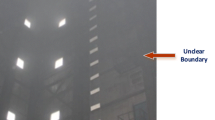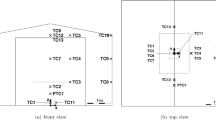Abstract
In case of fire, constructive features of typical atria could favor the spread of smoke. This makes the design of their smoke control and management systems a challenging task. Five full-scale fire experiments in the literature have been analyzed and numerically compared in FDS v6 to explore the influence of the make-up air. However, these fire experiments cover only a limited number of set-ups and conditions, and require further numerical modeling to obtain a deeper understanding of the makeup air influence. Subsequently, 84 simulations with FDS v6 have been carried out, considering different vent areas (air velocity from 0.4 to 5.3 m/s) and configurations, two heat release rates (2.5 and 5 MW), and two pan locations. It is demonstrated that make-up air velocities lower than the prescribed limit of 1 m/s, by the international codes, may induce adverse conditions. Based on our results, we recommended fire engineers to numerically assess the fire scenario with even lower velocity values. The results also show that asymmetric configurations are prone to induce circulation around the flame which can contribute to the formation of longer flames and fire whirls. Thus, this numerical study links two fire types allowing the connection of pool fires to fire whirls, which completely differ in behaviour and smoke filling, for the sake of design of fire safety.












Similar content being viewed by others
References
Alarie Y (2002) Toxicity of fire smoke. Crit. Rev. Toxicol. 32(4):259. https://doi.org/10.1080/20024091064246.
Chow W (1997) On the use of time constants for specifying the smoke filling process in atrium halls. Fire Saf J 28(2):165. https://doi.org/10.1016/S0379-7112(96)00071-9.
Mowrer FW (2002) Fire Technology 38(1):33. https://doi.org/10.1023/A:1013476730932.
Shi C, Lu W, Chow W, Huo R (2007) An investigation on spill plume development and natural filling in large full-scale atrium under retail shop fire. Int J Heat Mass Transf 50(3):513. https://doi.org/10.1016/j.ijheatmasstransfer.2006.07.020.
Capote JA, Alvear D, Abreu OV, Lázaro M, Espina P (2009) Fire Technology 45(2):201. https://doi.org/10.1007/s10694-008-0074-4.
Qin T, Guo Y, Chan C, Lin W (2009) Numerical simulation of the spread of smoke in an atrium under fire scenario. Building and Environment 44(1):56. https://doi.org/10.1016/j.buildenv.2008.01.014.
Hao-wei Y, Wen-li D, Dong L, Rogner A, Jing-wei L (2011) Procedia Engineering 11(Supplement C), 608. In: The 5th Conference on Performance-based Fire and Fire Protection Engineering. https://doi.org/10.1016/j.proeng.2011.04.703
Klote J.H (1994) Method of predicting smoke movement in atria with application to smoke management. NIST, Gaithersburg
NFPA 92, (2015) Standard for smoke control systems (National Fire Protection Association, Quincy, USA, 2015)
Council I.B (2009) International Building Code (International Building Council, 2009)
Hadjisophocleous G, Zhou JJ (2008) ASHRAE Transactions 114(1):147
Zhou J, Hadjisophocleous G (2008) ASHRAE Transactions 114(1):140
Hadjisophocleous GV, Lougheed GD (1999) International Journal on Engineering Performance-Based Fire Codes 1(3):183
Yi L, Chow W, Li Y, Huo R (2005) A simple two-layer zone model on mechanical exhaust in an atrium. Building and Environment 40(7):869. https://doi.org/10.1016/j.buildenv.2004.08.018.
Kerber S, Milke JA (2007) Fire Technology 43(1):45. https://doi.org/10.1007/s10694-007-0007-7
Pongratz C, Milke JA, Trouve A (2016) A CFD study to identify methods to increase maximum velocity of makeup air for atrium smoke control. ASHRAE Trans 122(2):10
Floyd J, Forney G, Hostikka S, Korhonen T, McDermott R, McGrattan K (2013) Fire Dynamics Simulator Version 6 Users Guide. 1st edn. National Institute of Standard and Technology, Gaithersburg
Zhang X, Yang M, Wang J, He Y (2010) Effects of computational domain on numerical simulation of building fires. J. Fire Prot. Eng. 20(4):225. https://doi.org/10.1177/1042391510367349.
Gutirrez-Montes C, Sanmiguel-Rojas E, Burgos MA, Viedma A (2012) On the fluid dynamics of the make-up inlet air and the prediction of anomalous fire dynamics in a large-scale facility. Fire Safety Journal 51:27. https://doi.org/10.1016/j.firesaf.2012.02.007
Ayala P, Cantizano A, Rein G, Vigne G, Gutiérrez-Montes C (2016) Fire Technology 52(1):51. https://doi.org/10.1007/s10694-015-0487-9.
Gutirrez-Montes C, Sanmiguel-Rojas E, Kaiser AS, Viedma A (2008) Numerical model and validation experiments of atrium enclosure fire in a new fire test facility. Building and Environment 43(11):1912. https://doi.org/10.1016/j.buildenv.2007.11.010.
Gutirrez-Montes C, Sanmiguel-Rojas E, Viedma A, Rein G (2009) Experimental data and numerical modelling of 1.3 and 2.3 MW fires in a 20 m cubic atrium. Building and Environment 44(9):1827. https://doi.org/10.1016/j.buildenv.12.010.
Gutirrez-Montes C, Sanmiguel-Rojas E, Viedma A (2010) Building and Environment 45(11):2458. https://doi.org/10.1016/j.buildenv.2010.05.006.
Ayala P, Cantizano A, Sánchez-Úbeda EF, Gutiérrez-Montes C (2017) Fire Technology 53(2):893. https://doi.org/10.1007/s10694-016-0609-z.
Beji T, Verstockt S, Van de Walle R, Merci B (2012) Journal of Fire Sciences 30(4):300. https://doi.org/10.1177/0734904112437845.
Hostikka S, Kokkala M, Vaari J (2001) NFSC2 Test Series, VTT Research Notes 2104; Technical Research Centre of Finland: Finland
Hill K, Dreisbach J, Joglar F, Najafi B, McGrattan K, Peacock R, Hamins A (2007) Verification and validation of selected fire models for nuclear power plant applications. Tech. Rep. NUREG 1824, United States Nuclear Regulatory Commission, Washington, DC
SFPE, (2002) Handbook of fire protection engineering, 3rd edn. Quincy, MA USA: National Fire Protection Association
Tohidi A, Gollner M.J, Xiao H (2018) Fire Whirls. Ann Rev Fluid Mech. https://doi.org/10.1146/annurev-fluid-122316-045209.
Janssens M, Tran HC (1992) Journal of Fire Sciences 10(6):528. https://doi.org/10.1177/073490419201000604.
He Y, Fernando A, Luo M (1998) Fire Safety Journal 31(1):19. https://doi.org/10.1016/S0379-7112(97)00064-7.
Acknowledgements
This research was supported by Fundación Mapfre, Institute for Research in Technology (IIT) of Universidad Pontificia Comillas, and the Spanish MINECO (Subdirección General de Gestión de Ayudas a la Investigación) under Project DPI2014-59292-C3-3. Moreover, these authors want to acknowledge the companies Sodeca, Xtralis and Gabriele Vigne of JVVA for the support during the full-scale fire experiments. Additionally, it is important to thank National Institute of Standard and Technology for making FDS available.
Author information
Authors and Affiliations
Corresponding author
Rights and permissions
About this article
Cite this article
Ayala, P., Cantizano, A., Rein, G. et al. Factors Affecting the Make-Up Air and Their Influence on the Dynamics of Atrium Fires. Fire Technol 54, 1067–1091 (2018). https://doi.org/10.1007/s10694-018-0725-z
Received:
Accepted:
Published:
Issue Date:
DOI: https://doi.org/10.1007/s10694-018-0725-z




